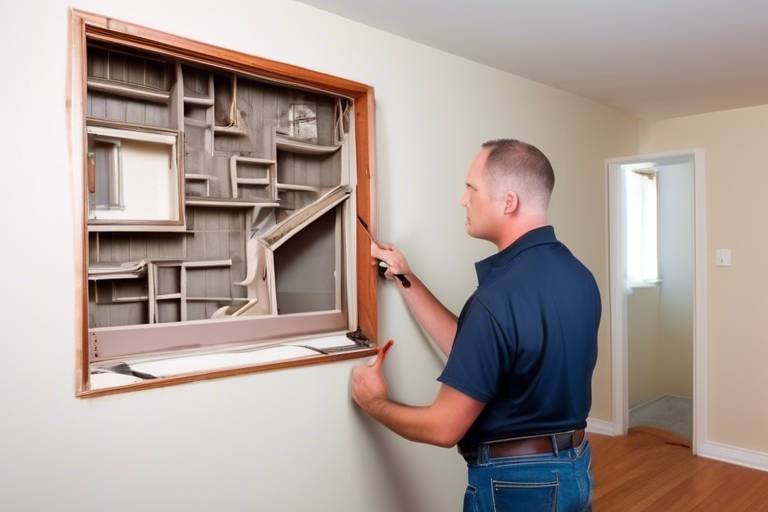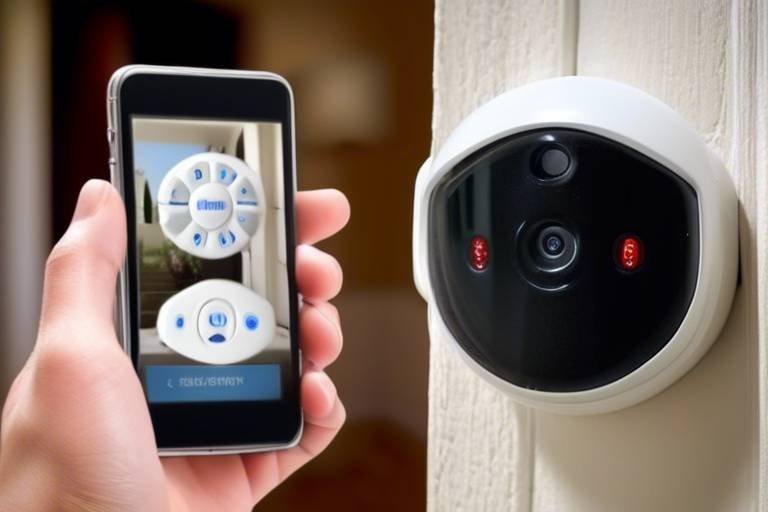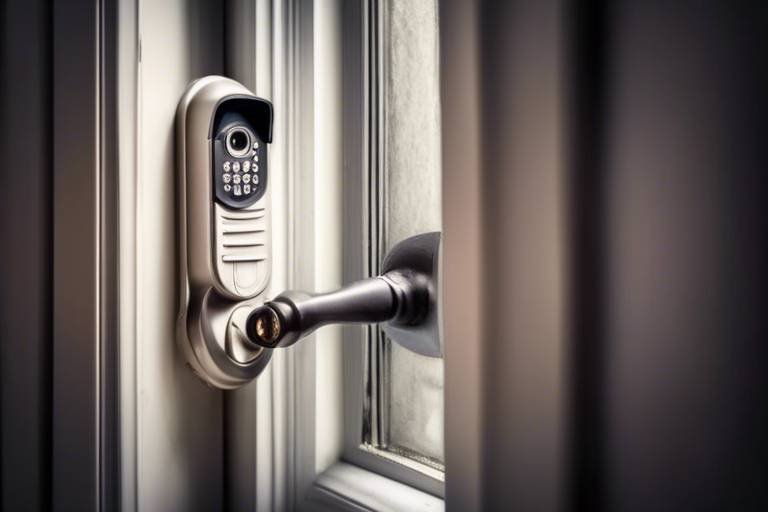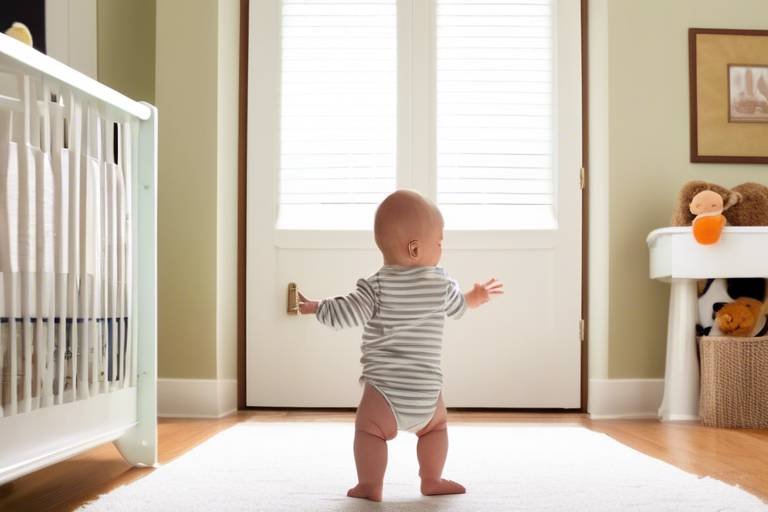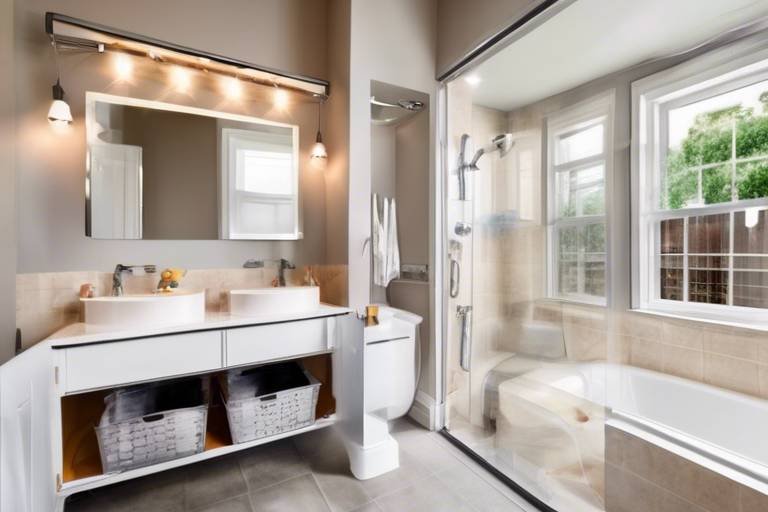Home Safety for People Suffering from Alzheimer's
Creating a safe living environment for individuals with Alzheimer's disease is not just a necessity; it's a crucial part of enhancing their quality of life. As the disease progresses, those affected may struggle with memory loss, confusion, and a decline in cognitive functions, which can lead to an increased risk of accidents at home. It's essential to implement strategies that not only prevent accidents but also promote independence. By understanding the unique challenges faced by these individuals, caregivers and family members can make informed decisions about modifications and safety measures that cater specifically to their needs.
Imagine walking through a home where every corner has been thoughtfully arranged to minimize risks and maximize comfort. This is the goal of home safety for people with Alzheimer's. It's not just about removing hazards; it's about creating an environment that feels familiar and secure. When we think about safety, we often focus on physical modifications, but emotional well-being plays a significant role too. A safe home should foster a sense of belonging and autonomy, allowing individuals to navigate their space with confidence.
As we delve into the various aspects of home safety for those suffering from Alzheimer's, we will explore practical modifications, room-by-room safety tips, and even the role of technology in enhancing safety. We'll also discuss the importance of emergency preparedness and effective communication strategies to ensure that everyone involved is on the same page. By the end of this article, you'll have a comprehensive understanding of how to create a safe haven for your loved ones, enabling them to maintain their dignity and independence while reducing the risk of accidents.
Alzheimer's disease is a progressive neurological disorder that affects memory, thinking, and behavior. It typically starts with mild memory loss and can eventually lead to severe cognitive impairment, impacting daily activities and overall quality of life. Common symptoms include forgetfulness, confusion about time and place, difficulty with problem-solving, and changes in mood or personality. Understanding these symptoms is vital for caregivers, as it helps them to tailor safety measures that address the specific challenges faced by their loved ones.
For instance, individuals may forget to turn off the stove or may not recognize dangerous situations, leading to potential accidents. This is where the importance of a safe home environment becomes apparent. By modifying living spaces and implementing strategies that cater to the unique needs of those with Alzheimer's, we can significantly reduce the risk of accidents and promote a sense of security.
Transforming a home into a safe haven for someone with Alzheimer's involves a mix of practical adjustments and thoughtful design. Start by removing tripping hazards such as loose rugs, clutter, and electrical cords that can easily lead to falls. Improving lighting is another critical step; bright, well-lit spaces can help reduce confusion and anxiety. Additionally, securing dangerous items like sharp objects, cleaning supplies, and medications is essential to prevent accidents.
Consider implementing a color-coded system for different rooms or essential items. For example, using contrasting colors for frequently used objects can help individuals with Alzheimer's locate them more easily. This simple yet effective strategy can enhance their sense of independence and reduce frustration.
When it comes to safety, each room in the house presents unique challenges and opportunities for improvement. Here’s a brief overview of what to consider for specific areas:
The kitchen can be a particularly hazardous area. To ensure safety, consider the following modifications:
- Use childproof locks on cabinets to prevent access to dangerous items.
- Remove sharp objects and replace them with safer alternatives.
- Utilize appliances designed for safety, such as slow cookers or induction cooktops that minimize the risk of burns.
The bathroom is another critical area where falls can occur. Enhancements such as:
- Installing grab bars near the toilet and in the shower can provide essential support.
- Using non-slip mats can help prevent slips and falls.
- Ensuring adequate lighting can reduce confusion, especially during nighttime visits.
In our modern world, technology can play a significant role in enhancing safety for individuals with Alzheimer's. Monitoring systems can alert caregivers if someone wanders outside or if there are unusual patterns in daily activities. Emergency alert devices can provide peace of mind, ensuring that help is just a button press away. Smart home features, such as automated lighting and security systems, can also contribute to a safer environment.
Creating an emergency plan tailored to the needs of individuals with Alzheimer's is crucial. This plan should be clear and simple, ensuring that all family members understand the procedures in case of an emergency. Regularly reviewing this plan can help everyone stay prepared and reduce anxiety during unforeseen situations.
Effective communication is key when discussing safety and emergency plans. Use clear, simple language and maintain a calm demeanor. It may help to repeat information and check for understanding, allowing individuals with Alzheimer's to feel more secure and involved in their safety plans.
Finally, incorporating engaging activities that promote cognitive function is essential. Activities like puzzles, gardening, or even simple board games can help individuals with Alzheimer's maintain a sense of purpose and enjoyment in their daily lives. It's about finding the right balance between safety and engagement, ensuring that every moment spent at home is not just safe but also fulfilling.
- What are the first steps to make a home safe for someone with Alzheimer's? Start by removing tripping hazards, improving lighting, and securing dangerous items.
- How can technology help in ensuring safety? Monitoring systems, emergency alert devices, and smart home features can enhance safety and provide peace of mind.
- What activities are suitable for cognitive stimulation? Engaging activities like puzzles, gardening, and board games can promote cognitive function and enjoyment.

Understanding Alzheimer's Disease
Alzheimer's disease is a progressive neurological disorder that primarily affects memory, thinking, and behavior. Imagine your brain as a library where all your memories are stored on bookshelves. As Alzheimer's progresses, it's as if someone is slowly removing those books, making it increasingly difficult to recall past events or even recognize familiar faces. This condition is not just about memory loss; it also influences a person's ability to perform everyday tasks, manage emotions, and communicate effectively.
The symptoms of Alzheimer's can vary widely from person to person, but they typically include:
- Memory loss: This is often one of the first signs, particularly forgetting recent conversations or events.
- Difficulty with problem-solving: Individuals may struggle with planning or following familiar recipes.
- Confusion about time or place: They may lose track of dates, seasons, and the passage of time.
- Changes in mood and personality: These can range from confusion and suspicion to depression and anxiety.
Understanding these symptoms is crucial for caregivers and family members. It helps in recognizing the subtle changes that might indicate the need for adjustments in the living environment. Tailored safety measures become essential, ensuring that individuals with Alzheimer's can maintain their independence while minimizing the risk of accidents. Just as you would childproof a home for a toddler, similar precautions are necessary for those with cognitive impairments, as their understanding of safety may diminish over time.
Moreover, Alzheimer's is not just a personal journey; it affects families and communities as well. The emotional toll on caregivers can be significant, often leading to feelings of frustration or helplessness. By understanding the disease better, caregivers can develop more effective strategies to support their loved ones, ensuring they feel safe and valued. This journey can sometimes feel like navigating through a fog, but with the right knowledge and tools, it can become more manageable.
In summary, recognizing the symptoms and understanding the impact of Alzheimer's disease is the first step towards creating a safer, more supportive environment. By doing so, we empower those affected to lead fulfilling lives despite the challenges they face.

Creating a Safe Home Environment
Creating a safe home environment for individuals suffering from Alzheimer's is not just a necessity; it’s a vital step in promoting their independence and well-being. An unsafe environment can lead to accidents that may cause injury or distress, which is why modifications to the home are essential. Imagine your home as a protective cocoon, one that nurtures and safeguards its inhabitants. By making thoughtful adjustments, you can significantly reduce risks and enhance the quality of life for your loved one.
One of the first steps in this process is to remove tripping hazards. This includes securing loose rugs, keeping pathways clear, and ensuring that furniture is arranged in a way that allows for easy movement. Picture the home as a smooth path in a park, where every step is safe and free from obstacles. Additionally, improving lighting throughout the house can make a world of difference. Bright, well-placed lights can help prevent falls and disorientation, especially in areas like hallways and staircases. Consider using motion-sensor lights that automatically turn on as someone approaches, providing a sense of security and visibility.
Another critical aspect is to secure dangerous items. This can include locking away cleaning supplies, medications, and sharp utensils. Childproof locks can be a simple yet effective solution. Think of these locks as guardians of safety, ensuring that potentially harmful substances are out of reach. In the kitchen, for example, it’s crucial to store knives and other sharp objects in places that are not easily accessible. Additionally, appliances designed for safety, such as slow cookers or automatic shut-off devices, can help mitigate risks while cooking.
Moreover, consider the layout of each room. For instance, in the living room, remove clutter and ensure that furniture is stable and well-arranged. In the bedroom, ensure that the bed is at an appropriate height and that there are no cords or wires that could pose a tripping hazard. Each room should feel like a safe haven, where your loved one can navigate with confidence. You might even want to create a
| Room | Modification | Status |
|---|---|---|
| Kitchen | Installed childproof locks on cabinets | Completed |
| Bathroom | Added grab bars and non-slip mats | In Progress |
| Living Room | Removed clutter and secured furniture | Completed |
Ultimately, creating a safe home environment is about more than just physical modifications; it’s about fostering a sense of security and comfort. Regularly assess the home for potential hazards and involve your loved one in discussions about their needs and preferences. This not only empowers them but also helps you to understand their perspective, making safety a shared responsibility. By taking these steps, you’re not just making changes to a physical space; you’re creating a nurturing environment where individuals with Alzheimer's can thrive.
Q: What are the first steps to take in making a home safer for someone with Alzheimer's?
A: Start by removing tripping hazards, improving lighting, and securing dangerous items like medications and sharp objects. Involve your loved one in discussions about their needs to make the process more comfortable for them.
Q: How can technology assist in creating a safer home environment?
A: Technology such as motion-sensor lights, monitoring systems, and emergency alert devices can enhance safety and provide peace of mind for caregivers and family members.
Q: Is it necessary to make changes in every room of the house?
A: While not every room may require extensive modifications, it’s important to assess each space individually and make adjustments based on the specific needs of the individual living there.

Room-by-Room Safety Tips
This article discusses essential strategies and modifications to ensure a safe living environment for individuals with Alzheimer's disease, focusing on preventing accidents and promoting independence.
Alzheimer's disease is a progressive neurological disorder that affects memory, thinking, and behavior. It can make daily activities increasingly challenging for those diagnosed. Symptoms often include confusion, difficulty with language, and changes in mood or behavior. These challenges highlight the need for tailored safety measures to create a secure living environment. By understanding these symptoms, caregivers can implement effective strategies to ensure that their loved ones remain safe and as independent as possible.
Creating a safe home for someone with Alzheimer's involves making thoughtful modifications that reduce hazards. Start by removing tripping hazards like loose rugs and clutter. Improving lighting is crucial, as it helps to reduce confusion and prevents accidents. Additionally, securing dangerous items, such as chemicals and sharp objects, is essential to ensure that the living space is safe. These adjustments not only help prevent accidents but also promote a sense of independence, allowing individuals to move around their homes with confidence.
When it comes to ensuring safety for individuals with Alzheimer's, it's essential to consider each room in the house. Each space presents unique challenges and opportunities for improvement. Let's break it down room by room:
The kitchen can be a particularly hazardous area due to sharp utensils and hot surfaces. To enhance safety, consider using childproof locks on cabinets to prevent access to dangerous items. It's also wise to remove sharp objects and replace them with safer alternatives, such as plastic utensils. Utilizing appliances designed for safety, like slow cookers and automatic shut-off devices, can significantly reduce risks while cooking or preparing meals. Always keep a first aid kit handy, just in case of minor accidents.
The bathroom is another critical area where falls can occur. Installing grab bars near the toilet and inside the shower can provide much-needed support. Non-slip mats are essential for preventing slips on wet surfaces. Adequate lighting is crucial, especially for nighttime use. Consider a nightlight or motion-activated lights to ensure visibility. Additionally, using a shower chair can make bathing safer and more comfortable, allowing individuals to maintain their hygiene without the risk of falling.
Embracing technology can significantly enhance safety for individuals with Alzheimer's. Monitoring systems can alert caregivers if a loved one wanders outside a designated area. Emergency alert devices are invaluable, allowing individuals to call for help at the push of a button. Smart home features, such as automated lighting and voice-activated appliances, can also make daily tasks easier and safer. By integrating these technologies, caregivers can provide peace of mind while promoting independence for those they care for.
Guidelines for creating an emergency plan tailored to the needs of individuals with Alzheimer's are crucial. All family members should be aware of procedures in case of an emergency. This includes knowing how to communicate effectively with the individual and understanding their specific needs during stressful situations.
Effective communication techniques are vital for caregivers and family members when discussing safety and emergency plans with individuals suffering from Alzheimer's. Using clear, simple language and maintaining a calm demeanor can help alleviate anxiety and confusion. It’s also helpful to have written instructions that can be easily referenced in case of an emergency.
Incorporating engaging activities that promote cognitive function while ensuring safety is essential. Activities such as puzzles, art projects, and even gardening can help individuals with Alzheimer's maintain a sense of purpose and enjoyment in daily life. These activities not only stimulate the mind but also provide opportunities for social interaction, which is beneficial for emotional well-being.
Q: What are some signs that my loved one may need home modifications?
A: Look for signs such as increased confusion, difficulty navigating the home, or frequent accidents. If you notice these changes, it may be time to assess your living space for safety improvements.
Q: How can I encourage independence while ensuring safety?
A: Focus on creating a safe environment that allows for easy navigation. Use labels, color coding, and visual cues to help your loved one find their way around the home. Empower them by involving them in safe activities they enjoy.
Q: Are there specific technologies that can assist in home safety?
A: Yes! Look into monitoring systems, emergency alert devices, and smart home technology that can help keep your loved one safe while allowing them to maintain independence.

Kitchen Safety Measures
The kitchen can be a bustling hub of activity, filled with delicious aromas and the promise of a home-cooked meal. However, for individuals suffering from Alzheimer's, it can also be a place fraught with hazards. Ensuring kitchen safety is paramount, and there are several modifications that can create a safer environment. One of the first steps is to remove sharp objects such as knives and scissors from easy reach. Consider using childproof locks on cabinets and drawers to prevent access to potentially dangerous items like cleaning supplies or sharp utensils. This simple change can significantly reduce the risk of accidents.
Another critical aspect of kitchen safety is the design and layout of the space. Keeping frequently used items at eye level can help individuals with Alzheimer's navigate the kitchen more easily. For example, you might want to place pots, pans, and utensils on lower shelves to minimize the need for reaching or climbing. Additionally, using appliances designed with safety features can make a world of difference. Look for options that have automatic shut-off functions, which can prevent fires or accidents if the appliance is left unattended.
Lighting is another key factor in maintaining a safe kitchen. Poorly lit areas can lead to missteps and accidents, so it's essential to ensure that the kitchen is well-lit. Consider installing bright LED lights and using motion-sensor lights in darker corners. This way, individuals can navigate the space safely, reducing the risk of falls. Furthermore, using contrasting colors for countertops and walls can help those with cognitive impairments better distinguish between surfaces, making it easier to identify where to place items.
For those who enjoy cooking, consider introducing one-step appliances that simplify the cooking process. Slow cookers and microwave ovens with pre-set functions can allow individuals to prepare meals with minimal supervision and effort. Additionally, it’s beneficial to establish a routine in the kitchen. Consistency can help individuals remember how to use appliances and prepare meals, which can be comforting and reduce confusion.
Lastly, it's essential to have a first aid kit readily available in the kitchen, stocked with necessary supplies like band-aids, antiseptics, and any prescribed medications. This ensures that in the event of a minor injury, assistance is close at hand. By taking these kitchen safety measures, we can create a nurturing environment that allows individuals with Alzheimer's to maintain their independence while minimizing risks. Remember, the goal is to make the kitchen a safe space where culinary creativity can flourish without compromising safety.
- What are the most important safety modifications for the kitchen?
Essential modifications include removing sharp objects, using childproof locks, improving lighting, and choosing appliances with safety features. - How can I help my loved one feel comfortable in the kitchen?
Create a consistent routine, keep frequently used items accessible, and encourage one-step cooking appliances to promote independence. - What should I include in a kitchen first aid kit?
Include band-aids, antiseptics, gauze, and any necessary medications for quick access in case of minor injuries.

Bathroom Safety Enhancements
When it comes to ensuring safety for individuals with Alzheimer's, the bathroom can pose unique challenges. It's often a place where slips and falls can occur, especially when someone is dealing with cognitive impairments. Therefore, enhancing bathroom safety is not just a precaution; it's a necessity. Imagine stepping into a room filled with potential hazards—hard surfaces, slippery floors, and sharp edges. It’s crucial to transform this space into a haven of safety and comfort.
One of the first steps in bathroom safety is the installation of grab bars. These sturdy bars should be placed near the toilet and inside the shower or bathtub. They provide essential support for individuals who may struggle with balance. Think of grab bars as a lifeline, offering stability and confidence during daily routines. Additionally, consider using non-slip mats on the floor and inside the tub. These mats are designed to grip the surface, significantly reducing the risk of slipping. Imagine stepping out of a shower onto a safe, secure surface instead of a slick tile floor.
Lighting is another critical factor that can’t be overlooked. Bright, adequate lighting can make a world of difference in preventing accidents. Installing motion-sensor lights can be particularly beneficial, as they illuminate the space automatically when someone enters. This way, individuals with Alzheimer's won’t have to fumble for light switches in the dark. Furthermore, consider using night lights to guide the way during nighttime trips to the bathroom. It’s like having a friendly beacon, gently leading the way and reducing confusion.
Moreover, keeping the bathroom organized and free from clutter is essential. A tidy space not only looks better but also minimizes distractions and confusion. It's a good idea to store frequently used items within easy reach, avoiding the need for individuals to bend down or stretch up to grab something. Think of it as creating a user-friendly zone that promotes independence while ensuring safety. You might even want to label cabinets and drawers to help with memory recall. Simple labels can act like little reminders, making it easier to find what they need without frustration.
In addition to these enhancements, consider implementing toilet seat risers to make sitting down and standing up easier. These devices can alleviate strain and provide additional height, making the process more comfortable. It’s like giving a helping hand when it’s most needed. Lastly, ensure that all medications and cleaning supplies are stored securely out of reach. Childproof locks can be a smart addition to cabinets, preventing accidental ingestion or misuse.
In summary, enhancing bathroom safety for individuals with Alzheimer's involves a combination of physical modifications and thoughtful organization. By implementing grab bars, non-slip mats, adequate lighting, and maintaining a clutter-free environment, you can create a safer space that promotes independence. Remember, a safe bathroom is not just about preventing accidents; it’s about providing peace of mind for both the individual and their caregivers. After all, when safety is prioritized, everyone can enjoy a little more comfort in their daily routines.
- What are the most important bathroom modifications for Alzheimer's patients? The most crucial modifications include installing grab bars, using non-slip mats, ensuring proper lighting, and keeping the space organized.
- How can I make the bathroom more accessible? Consider using toilet seat risers, placing commonly used items within easy reach, and labeling cabinets to assist with memory recall.
- Why is lighting important in the bathroom? Adequate lighting helps prevent falls and accidents by ensuring individuals can see clearly, especially during nighttime trips.
- Are there any specific products recommended for bathroom safety? Yes, products like grab bars, non-slip mats, and motion-sensor lights are highly recommended for enhancing safety.

Technology Aids for Safety
In today's fast-paced world, technology has become an invaluable ally in ensuring the safety of individuals suffering from Alzheimer's disease. With the right technological aids, caregivers can enhance the living environment, allowing for greater independence while also minimizing risks. Imagine being able to monitor a loved one’s movements in real-time, or having a device that alerts you when they wander too far from a designated safe zone. These innovations not only provide peace of mind but also empower individuals with cognitive impairments to maintain a sense of autonomy.
One of the most significant advancements in this area is the use of monitoring systems. These systems can include video cameras, motion sensors, and wearable devices that track activity levels. For instance, a simple motion sensor placed near doorways can alert caregivers when someone attempts to leave the house. This not only helps prevent wandering but also allows caregivers to respond quickly if an individual is in distress. Additionally, some systems can send notifications directly to smartphones, ensuring that caregivers are always in the loop, no matter where they are.
Another essential technology is the emergency alert device. These devices can be worn as necklaces or bracelets and are designed for quick access during emergencies. With just the push of a button, individuals can alert caregivers or emergency services if they feel unsafe or are experiencing a medical issue. This feature is particularly important for those who may struggle to communicate their needs verbally. The reassurance that help is just a button away can significantly reduce anxiety for both the individual and their family members.
Smart home technology also plays a crucial role in enhancing safety. Features such as automated lighting can help prevent falls by ensuring that pathways are well-lit during the night. Imagine coming home to a house where the lights automatically turn on as you enter a room, creating a welcoming and safe environment. Smart thermostats can also be programmed to maintain comfortable temperatures, preventing heat-related issues or cold exposure. Furthermore, smart locks can be installed to secure entry points, allowing caregivers to control access without needing to replace traditional locks.
To illustrate the various technology aids available, consider the following table that summarizes some popular options:
| Technology Aid | Function | Benefits |
|---|---|---|
| Monitoring Systems | Tracks movements and alerts caregivers | Prevents wandering and ensures safety |
| Emergency Alert Devices | Allows immediate contact for help | Provides peace of mind and quick response |
| Smart Home Features | Automates lighting, temperature, and security | Enhances safety and comfort |
While these technological aids can significantly improve safety, it’s essential to choose devices that suit the specific needs of the individual. Caregivers should consider factors such as ease of use, reliability, and the level of support required. Additionally, integrating these technologies into daily routines can help individuals feel more comfortable and less overwhelmed by the changes in their environment.
In conclusion, embracing technology can transform the living space of someone with Alzheimer's disease into a safer, more manageable environment. By leveraging these tools, caregivers can not only protect their loved ones but also promote their independence, allowing them to enjoy life to the fullest. As we continue to innovate and adapt, the future looks brighter for those living with Alzheimer's and their families.
- What types of monitoring systems are available for Alzheimer's patients?
There are various options, including video surveillance, motion detectors, and wearable GPS trackers that can alert caregivers if the individual wanders outside a designated area. - Are emergency alert devices easy to use?
Yes, most emergency alert devices are designed to be user-friendly, often featuring a simple button that can be pressed in case of an emergency. - How can smart home technology help with safety?
Smart home devices can automate lighting, regulate temperature, and secure doors, all of which contribute to a safer living environment for individuals with cognitive impairments.

Emergency Preparedness
When it comes to ensuring the safety of individuals suffering from Alzheimer's disease, having a solid emergency preparedness plan is crucial. Imagine the peace of mind that comes from knowing you have a strategy in place for any unexpected situation. Whether it's a natural disaster, a medical emergency, or simply a moment of confusion, being prepared can make all the difference. The key is to tailor your emergency plan specifically to the needs of the person with Alzheimer's, considering their unique challenges and capabilities.
Start by creating a comprehensive emergency plan that everyone in the household understands. This plan should include important details such as emergency contacts, medical information, and specific instructions tailored to the individual’s needs. For instance, if the person has a history of wandering, ensure that the plan includes measures to quickly locate them. It’s also wise to have a list of local emergency services, hospitals, and any nearby relatives or friends who can assist in a crisis.
In addition to a written plan, consider conducting regular drills with the family. Just like fire drills in schools, practicing your emergency procedures can help everyone feel more confident and prepared. This is especially important for individuals with Alzheimer's, as familiarity can ease anxiety. Make sure to explain the drills in simple terms and repeat them often. This repetition can help reinforce the information and make it easier for them to recall during an actual emergency.
Another vital aspect of emergency preparedness is having an easily accessible emergency kit. This kit should include essential items such as:
- First aid supplies
- Medications and a list of prescriptions
- Flashlights and extra batteries
- Non-perishable food and water
- Comfort items such as a favorite blanket or photo
Having these items readily available can significantly reduce stress during an emergency. Make sure to keep the kit in a location that is easy to access but also safe from potential hazards.
Moreover, consider utilizing technology to enhance safety. There are various devices and apps available that can assist in monitoring the individual’s whereabouts and health. For instance, GPS tracking devices can provide real-time location updates, while emergency alert systems can notify caregivers immediately if assistance is needed. These technological aids can offer both the individual and their caregivers a sense of security, knowing help is just a button press away.
Finally, don’t forget to communicate openly with the individual about the emergency plan. While it’s important to be sensitive to their feelings, having discussions about safety can empower them and reduce anxiety. Use simple language and be patient, allowing them to ask questions and express their concerns. This not only helps them understand the plan but also fosters a sense of control in their lives.
Q: What should I include in an emergency kit for someone with Alzheimer's?
A: Your emergency kit should include first aid supplies, medications, non-perishable food, water, flashlights, and comfort items.
Q: How often should I review and practice the emergency plan?
A: It’s recommended to review the plan every few months and conduct practice drills regularly to ensure everyone is comfortable with the procedures.
Q: Are there specific technologies that can help with emergency preparedness?
A: Yes, GPS tracking devices and emergency alert systems can greatly enhance safety and provide peace of mind for caregivers.
Q: How can I communicate the emergency plan effectively with someone who has Alzheimer's?
A: Use simple language, be patient, and allow them to ask questions. Repetition can also help reinforce the plan.

Communication Strategies
Effective communication is crucial when caring for individuals with Alzheimer's disease. It’s not just about what you say; it’s also about how you say it. Think of communication as a bridge connecting two worlds: one where clarity reigns and another where confusion lurks. To foster understanding, caregivers must adapt their communication styles to meet the unique needs of those affected. Here are some strategies to consider:
First and foremost, be patient. People with Alzheimer's may struggle to find the right words or follow conversations. Instead of rushing them, give them the time they need to express themselves. You might even find that a gentle pause can invite more thoughtful responses. Imagine waiting for a flower to bloom; it takes time, but the result is worth the wait.
Another effective strategy is to use simple language. Avoid jargon or complicated phrases. Instead, opt for clear, straightforward sentences. For instance, instead of saying, “Would you like to have a snack?” you might say, “Do you want an apple?” This small change can make a big difference in comprehension.
Additionally, maintaining eye contact and using a calm tone can create a sense of safety and connection. When you look someone in the eyes, it’s like saying, “I’m here with you.” This non-verbal cue can help reinforce that you are engaged and attentive, making it easier for them to open up.
Visual aids can also play a significant role in communication. Consider using pictures or written cues to convey messages. For example, if you’re trying to explain the day’s activities, presenting a simple schedule with images can provide clarity. It’s like giving them a map to navigate their day, reducing anxiety about what comes next.
Moreover, being aware of emotional cues is essential. Sometimes, it’s not just about the words being spoken but the feelings behind them. If they seem frustrated or upset, acknowledge those emotions with empathy. Phrases like “I can see this is hard for you” can validate their feelings and foster a supportive environment.
Lastly, always encourage participation in conversations. Ask open-ended questions that invite them to share their thoughts or memories, but be prepared for answers that might not always make sense. Think of it as a dance; sometimes, you lead, and other times, you follow. This approach not only helps maintain their dignity but also keeps them engaged and active in the dialogue.
In summary, effective communication with individuals suffering from Alzheimer's involves a blend of patience, clarity, visual aids, emotional awareness, and encouragement. By adapting your strategies, you can build a stronger connection that enhances their sense of security and belonging.
- What is the best way to start a conversation with someone who has Alzheimer's?
Begin with familiar topics or memories. Use their name and engage in gentle, open-ended questions to spark interest.
- How can I help them feel understood?
Practice active listening, maintain eye contact, and respond to their emotions. Show empathy and patience.
- Should I correct them if they say something inaccurate?
It’s often best to avoid correcting them. Instead, gently steer the conversation back to a more comfortable topic.
- How can visual aids help in communication?
Visual aids like pictures or written notes can simplify complex information, making it easier for them to understand and engage.

Engaging Activities for Cognitive Stimulation
When it comes to individuals suffering from Alzheimer's, keeping their minds active is crucial. Engaging activities not only provide cognitive stimulation but also enhance their overall well-being. Think of the brain as a muscle; just like any other muscle in our body, it needs regular exercise to stay strong and healthy. So, how do we ensure that our loved ones with Alzheimer's get the mental workout they need?
First off, it's essential to choose activities that are both enjoyable and appropriate for their cognitive level. This means understanding their interests and capabilities. For example, if the person loved gardening before their diagnosis, why not encourage them to tend to some potted plants? This not only stimulates their mind but also gives them a sense of purpose. Activities should be simple yet fulfilling, allowing them to experience success without frustration.
Here are some engaging activities that can help spark cognitive function:
- Puzzles: Jigsaw puzzles or crossword puzzles can be an excellent way to challenge the mind. They promote problem-solving skills and can be completed at their own pace.
- Art Projects: Encourage creativity through painting or coloring. Art allows for self-expression and can be incredibly therapeutic.
- Music Therapy: Listening to music or even singing familiar songs can evoke memories and improve mood. Consider creating a playlist of their favorite tunes.
- Memory Games: Simple memory games can be adapted to suit their cognitive level. Use cards with pictures or words that hold significance to them.
In addition to these activities, incorporating routine can be beneficial. Routines provide structure and familiarity, which can be comforting for someone with Alzheimer's. For instance, setting aside specific times each day for activities can help them anticipate and look forward to these moments. You might create a weekly schedule that includes various engaging activities, ensuring that there's always something stimulating on the horizon.
Moreover, involving family and friends in these activities can enhance the experience. Social interactions can significantly boost cognitive function and help reduce feelings of isolation. Whether it's a family game night or a group art session, the more, the merrier! Just remember to be patient and supportive, as the goal is to enjoy the time spent together rather than to achieve a specific outcome.
Lastly, always be mindful of safety. While engaging in activities, ensure that the environment is secure and free of any hazards. This way, individuals can focus on enjoying their activities without any worries. By providing a safe and stimulating environment, we can help our loved ones with Alzheimer's maintain a sense of purpose and joy in their daily lives.
Q: What types of activities are best for someone with Alzheimer's?
A: Activities that are simple, enjoyable, and familiar work best. Consider puzzles, art projects, music, and memory games that cater to their interests.
Q: How can I encourage participation in activities?
A: Make activities social and fun! Invite family members to join in, and be patient. It's essential to focus on enjoyment rather than performance.
Q: How often should these activities be done?
A: Aim for daily engagement, but be flexible. It's important to observe their mood and energy levels, adjusting the frequency as needed.
Frequently Asked Questions
- What are some common symptoms of Alzheimer's disease?
Alzheimer's disease often presents with symptoms such as memory loss, confusion, difficulty in completing familiar tasks, and changes in mood or behavior. These symptoms can vary widely among individuals, making it essential to tailor safety measures accordingly.
- How can I make my home safer for someone with Alzheimer's?
To enhance safety, consider removing tripping hazards like rugs, improving lighting, and securing dangerous items such as knives and chemicals. Additionally, using labels for rooms and items can help individuals navigate their environment more easily.
- What specific safety measures should I take in the kitchen?
In the kitchen, it's vital to use childproof locks on cabinets, remove sharp objects, and utilize appliances designed for safety. Keeping a clutter-free space can also minimize risks during meal preparation.
- How can I improve bathroom safety for someone with Alzheimer's?
Enhancing bathroom safety can be achieved by installing grab bars, using non-slip mats, and ensuring adequate lighting. These modifications can significantly reduce the risk of falls and accidents during daily routines.
- Are there technological aids that can help ensure safety?
Yes! There are numerous technological solutions available, such as monitoring systems, emergency alert devices, and smart home features. These tools can provide peace of mind for caregivers and enhance the safety of individuals with Alzheimer's.
- What should be included in an emergency plan for someone with Alzheimer's?
An effective emergency plan should outline clear procedures for various scenarios, such as medical emergencies or natural disasters. It's essential that all family members are familiar with the plan and practice it regularly.
- How can I communicate safety plans effectively with someone suffering from Alzheimer's?
When discussing safety plans, use simple language and be patient. Visual aids can also help convey information more clearly. It's important to ensure that the individual feels involved and understood during these conversations.
- What types of activities can help stimulate cognitive function?
Engaging activities like puzzles, memory games, and arts and crafts can promote cognitive function while ensuring safety. These activities provide a sense of purpose and enjoyment, which is crucial for maintaining mental health.





